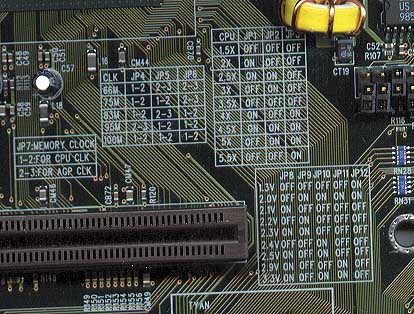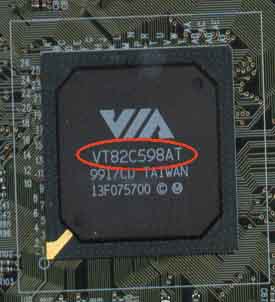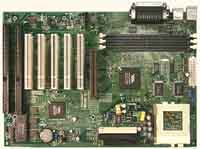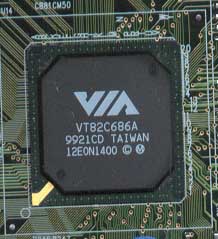
Original Link: https://www.anandtech.com/show/361
Tyan S1598 Trinity MVP3 ATX
by Anand Lal Shimpi on August 18, 1999 10:24 PM EST- Posted in
- Motherboards
For updated information on this motherboard check out our Head to Head comparison that includes this board
Would you ever buy a toaster made by Porsche? It's a funny thought but a very valid question designed to prove a point, just because a company excels at producing a particular type of product, in the case of Porsche it would be high performance sports cars, doesn't mean that they will excel at making any type of product their engineers come up with. Not to boost the ego of the Freemont, CA based motherboard manufacturer too much, but when it comes to server motherboards Tyan has generally produced the "Porsches" of the industry, not only in terms of performance, but in terms of quality and reliability. When Tyan started making more end-user level boards, many users thought they'd be receiving all the quality and attention Tyan's impressive line of server/workstation motherboards were granted, just at a lower cost. Unfortunately, as with any other leader in the industry, Tyan seemed to have a dry spell of poorly manufactured boards dating back to some of the later Socket-7 motherboards they produced.
The company has definitely noticed a comeback in recent times, the quality of their server motherboards have improved, the name Tyan is once again associated with the idea of reliable motherboards and in general, all is well. When Tyan introduced their first Super7 motherboard, the Trinity 100 ATX, the response wasn't that great simply because the board itself wasn't that great of a motherboard. One of the original shortcomings of the K6-2 and K6-III processors is that they haven't been given the opportunity to be paired up with motherboards that are truly deserving of their processing power, a fear that many users have for the future of AMD's latest concoction, the Athlon. Luckily, the adage "better late than never" seems to apply quite well to the Super7 industry as many motherboard manufacturers are going back to the drawing boards to revamp their Super7 designs, present company included. What is the result from Tyan's efforts?
Enter the Tyan Trinity S1598 ATX...
| CPU Interface | Super Socket-7 |
| Chipset | VIA MVP3 |
| L2 Cache | 1MB |
| Form Factor | ATX |
| Bus Speeds | 66 / 75 / 83 / 95 / 100 |
| Clock Multipliers | 1.5x - 5.5x |
| Voltages Supported | 1.3v - 3.5v (0.1v increments) |
| Memory Slots | 3 168pin DIMM Slots |
| Expansion Slots | 0 AMR 1 AGP Slot 5 PCI Slots (5 Full Length) 2 ISA Slots (1 Full Length) |
| BIOS | Award BIOS 4.51PG |
The Good
| The Tyan Trinity S1598 (referred to as the S1598 from now on, no points were deducted from Tyan's score for having an annoyingly long product name) features a layout that has been perfected over and over again over the past two years and has finally become the unspoken standard when it comes to motherboards. The board features the ever-so-popular 5/2/1 expansion slot configuration (PCI/ISA/AGP), with all five PCI slots capable of accepting full length cards and one of the two ISA slots capable of accepting a full length card as well. Provided that you don't make use of the PC speaker connector (J4) nor the ACPI LED connector (J5) on the motherboard the first ISA slot is then capable of accepting a full length card as well. | |
| The board seems quite barren, as do most Super7 motherboards, featuring nine 1000uF electrolytic capacitors surrounding the two switching voltage regulators on the board as well as three 100uF and 2 10uF capacitors. The S1598 has a few places for additional capacitors silk-screened onto the PCB, however for one reason or another the capacitors were hastily pulled from the design. | |
Following the older Super7 motherboard design layouts, the S1598 places the 3 DIMM slots at the upper right hand corner of the motherboard directly below the ATX I/O connectors. Directly below the 3rd DIMM slot lies the 598AT North Bridge, which makes up half of the MVP3 chipset featured on the S1598, the other half obviously coming from the 686A Super South Bridge controller that provides features such as the Ultra ATA 66 support the board boasts. To the right of the North Bridge are the two 512KB 4ns Winbond L2 cache chips and the 8ns 32Kx8 EliteMT Tag RAM module. The board does feature a silk-screened space for a 64Kx8 Tag RAM module, however that option is most likely open for OEM configuration as is the L2 cache size which Tyan offers as 512KB or 2MB in addition to the standard 1MB version. Obtaining a version other than the 1MB S1598, as briefly mentioned, is most likely an option reserved to OEMs alone as the costs associated with releasing three different version of the same motherboard to end users buying one or two boards at most wouldn't be in the best interests of Tyan as a company.
The cacheable memory region of the S1598 is defined by the L2 cache that is present on the board in the form of two 512KB chips, forming a total of a 1MB on-board L2 cache as we just discussed. The actual cacheable memory region of the motherboard is 254MB, meaning that if any memory is accessed above the 254MB limit, it will result in degraded performance during the accessing of the data stored within that memory space. This, of course, does not apply to K6-3 systems, whose on-chip L2 cache takes care of the cacheable memory area of the system.
Surrounded by the Socket-7 CPU interface is a 3/4" thermistor designed to report CPU temperature data to the hardware monitoring integrated into the 686A Super South Bridge controller. Unlike the older Mobile South Bridge (596B), the 686A Super South Bridge boasts a handful of integrated features such as hardware monitoring. Among the other supported features is Ultra ATA 66 support, support for an on-board AMR slot (see Intel 810 Review) and the audio/modem codecs that power it. Unfortunately Tyan chose to take no advantage of the added features of the Super South Bridge outside of the Ultra ATA 66 support, however an Audio I/O connector is silk-screened onto the motherboard potentially for OEM configuration as indicated in the User's Manual. |
|

Easy to access, and easy to read
Due to the layout of the S1598, ample room is provided for all jumper settings to be printed directly on the motherboard, making the setup and configuration of the board quite simple. The available core voltage settings are controlled by a 10-pin jumper block that enables the support of 21 core voltage settings, ranging from 1.3v to 3.5v in 0.1v increments. Towards the ATX PS connector are two jumper blocks placed flush against one another, with the first 10-pin jumper block controlling the FSB setting (66/75/83/95/100MHz) then the following six pins controlling the clock multiplier setting, ranging from 1.5x to 5.5x with the 3.5x multiplier corresponding to the 1.5x multiplier on older CPUs and the 2.0x multiplier representing the 6.0x multiplier on newer K6-III and K6-2 CXT CPUs. Placed between the FSB and clock multiplier jumpers is the obscurely located JP7 whose setting controls whether the memory clock will operate synchronously with the FSB or the AGP clock, a praised feature of the MVP3 chipset.
A feature not reserved to the S1598 alone but to all MVP3 based motherboards (finally) is a single driver configuration package that automatically installs all the required drivers and patches for the MVP3 chipset under Windows 9x/NT. The software driver package is known as the VIA Service Pack 4.01, or 4-in-1 driver for short. The 4-in-1 package is essentially all four necessary drivers and patches (IDE Busmaster, VIA AGP, IRQ Routing, VIA Registry - ACPI) to help your system work properly the first time, without having to tweak settings, disable AGP 2X mode, or anything of the sort, which many Super7 users were used to simply because they didn't have the drivers installed properly. A driver release like the 4-in-1 is long overdue on VIA's part, but as the old adage goes, it's better late than never and quite a few Super7 users will be happy to know that VIA finally got their act together, at least on the driver side of things. The 4-in-1 comes bundled on Tyan's driver's and utility's CD-ROM, however it is also available for download at VIA's website. The included CD-ROM also features a hardware monitoring utility and an on-line copy of the User's Manual, it would have been nice to see bundled Anti-Virus software like most of the other motherboard manufacturers, but it isn't a requirement.
A unique PC'99 inspired feature of the S1598 is the ACPI LED header on the motherboard (the connector that, when used, prevents a full length ISA card from being installed). The 3-pin connector provides a two color LED connection for your case. When your system is turned on, the LED is green, if it is in suspend/stand-by mode, the LED will be yellow and if you are receiving an incoming message, the LED will flash. The S1598 is definitely the first Super7 board, if not the first motherboard ever to stroll into the AnandTech lab with this cute little feature. It's nothing earth shattering, but it's not completely useless either.
Unlike most motherboard manufacturers these days, Tyan is still sticking to the standard written User's Manual that is bundled with the S1598. While most others have gone the route of cutting costs by including only a quick start guide (if that) and an on-line manual, Tyan's high quality user's manual is back with the S1598 in addition to being available in a PDF format on the bundled CD-ROM mentioned above.
The stability of the Tyan board was impressive for a Super7 board, easily outpacing quite a few of the competing boards in its class. The performance of the S1598 was also noticeably greater than some of the fastest competing motherboards, normally the performance of a motherboard isn't something we generally like to give points for however in the case of the S1598 the difference was definitely noteworthy.
The Bad
Looking around at the competition, Tyan honestly didn't have to do much to make the S1598 a superior board to most others available on the market today. While that isn't necessarily a bad thing, in this case, it is. The Super7 motherboard industry, as a whole, has been extremely disappointing. While some may argue that the K6-2 is by no means a good CPU solution, the K6-III undoubtedly is. For a user that isn't a hard core gamer, the K6-III delivers very strong performance across the board in integer applications. Even under games, with 3DNow! support growing in both games and drivers, the K6-III isn't as bad of a gaming solution as the K6-2 was towards the start of its introduction. The problem? Most Super7 motherboards out there are very poorly made.
The S1598 improves on the overall quality we've come to expect from Super7 motherboards, however the true potential of the board is left untapped. The 686A South Bridge could easily support an AMR slot, and getting rid of at least one of the two ISA slots on the board in favor of adding a sixth PCI slot would be a definite plus for users interested in future expansion.
The 4ns L2 cache on the S1598 is very impressive, but what isn't impressive is the 8ns L2 Tag RAM that would definitely hinder any overclocking the 4ns L2 cache would make possible, and if that weren't the worst part, as far as overclocking past the 100MHz FSB is concerned, the S1598 doesn't do it. Especially for K6-2 users that are limited by the 100MHz frequency of their L2 cache, a 112MHz FSB setting at the least would be a very welcome option, however Tyan's young roots in overclocking kept those options out of the feature list for the S1598.
The biggest complaint we had with the S1598 was the VT82C598AT North Bridge used on the board. Hopefully the sample AnandTech received was the only one to feature this North Bridge as the 598AT was discontinued and then remanufactured under the VT82C598MVP with a few major bug fixes and pin changes. If you remember back to the days of the i740 incompatibility problems with the MVP3 chipsets (revision CD of the 598AT to be specific, revision CE corrected the problems) you'll remember that the chipset revision to stay away from was the CD revision of the VT82C598AT, the same exact chip used on the S1598 we received. |
 |
| Although the board worked fine with the Voodoo3 we tested it with, a few hiccups and problems reminiscent of chipset incompatibilities seemed to arise as soon as we tossed in the TNT2 which takes full advantage of the AGP 2X specification. We're going to give Tyan the benefit of the doubt and assume that the 598AT was just a honest mistake, and that the 598MVP chipset was supposed to be present on the S1598 but to be on the safe side, you should definitely check with your vendor to make sure you're getting the most up to date board. There is absolutely no reason you should have to settle for a chipset that has since been re-released after a few bugs were discovered. Shame on Tyan. | |
The S1598 definitely had the potential to grow into a killer motherboard for the Super7 market, but it seems like shortcomings are to be expected from motherboard manufacturers when it comes to making Super7 boards. Hopefully manufacturers will take the Athlon a bit more seriously than they did the K6-x series of processors, only time will tell.
USB Compatibility
Number of Front Universal Serial Bus Root Ports: 0
Number of Rear Universal Serial Bus Root Ports: 2
USB IRQ Enable/Disable in BIOS: Yes
USB Keyboard Support in BIOS: Yes
Recommended SDRAM
Recommended SDRAM:
Mushkin SEC -GH PC100 SDRAM; Memory Man SEC -GH PC100 SDRAM
SDRAM Tested: 1 x 128MB Mushkin PC100 SDRAM; 1 x 128MB Memory-Man PC100 SDRAM; 1 x 256MB
Corsair PC100 SDRAM DIMM (for compatibility testing only)
Manufacturer: The
Memory Man
Purchase Web-Site: http://www.memory-man.com
Manufacturer: Mushkin
Purchase Web-Site: http://www.mushkin.com
The Test
In recent times, choosing a motherboard cannot be completely determined by a Winstone score. Now, many boards come within one Winstone point of each other and therefore the need to benchmark boards against each other falls. Therefore you shouldn't base your decision entirely on the benchmarks you see here, but also on the technical features and advantages of this particular board, seeing as that will probably make the greatest difference in your overall experience.
Click Here to learn about AnandTech's Motherboard Testing Methodology.
Test Configuration |
|
| Processor(s): | AMD K6-2 450 AMD K6-III 450 |
| RAM: | 1 x 64MB Mushkin
PC100 SDRAM 1 x 64MB Memory-Man PC100 SDRAM |
| Hard Drive(s): | Western Digital Caviar AC28400 - UltraATA/33 |
| Bus Master Drivers: | VIA 4-in-1 Service Pack BM Drivers |
| Video Card(s): | 3dfx Voodoo3 3000 |
| Operation System(s): | Windows 98 SE |
| Motherboard Revision: | Tyan S1598 Trinity ATX Revision 1.0 |
Windows 98 Performance |
||||
Business |
Q3 Test 1.08 demo1.dm3 | |||
| Fastest | Fast | Normal | ||
| AMD K6-2 450 | 17.2 | 60.7 | 48.3 | 43.7 |
| AMD K6-III 450 | 20.1 | 75.1 | 62.1 | 53.7 |
The S1598 isn't a bad board at all, in fact, it is one of the best Super7 boards you can possibly lay your hands on. However, the board isn't worth a penny of your time unless it features the most up-to-date VT82C598MVP North Bridge, why should you settle for a buggy chipset? Epox is just around the corner...
Overall, the S1598 is very promising. Compared to Tyan's Slot-1 and Slot-2 server solutions, the board is crap, however compared to the rest of the Super7 motherboards available, the S1598 is a very rare creation that is actually a very decent Super7 solution. While it may not be the best for K6-2 users looking to overclock (K6-III users don't get too big of a benefit from increased FSB vs increased clock due to the on-chip L2 cache), it does offer enough voltage tweaking settings and clock multiplier settings to give you at least a small opportunity to overclock.
If overclocking isn't your game then the Ultra ATA 66 support is a definite plus, and for the beginners, the User's Manual measures up to Tyan's usual standards. A good board, with a few easily correctable problems, let's hope Tyan takes care of them.
AnandTech Motherboard Rating |
|
Rating |
|
| Performance | 88% |
| Price | 84% |
| Ease of Use | 82% |
| Overclocked Stability | N/A |
| General Stability | 90% |
| Quality | 86% |
| Documentation | 93% |
| Reliability | 84% |
| Overall Rating | 87% |
Click Here to learn about AnandTech's Motherboard Testing Methodology.









